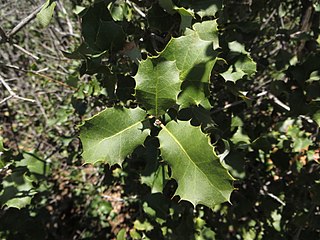
The Peninsular Ranges are a group of mountain ranges that stretch 1,500 km (930 mi) from Southern California to the southern tip of the Baja California peninsula; they are part of the North American Pacific Coast Ranges, which run along the Pacific Coast from Alaska to Mexico. Elevations range from 150 to 3,300 m.

Chrysolepis is a small genus of plants in the family Fagaceae, endemic to the western United States. Its two species have the common name chinquapin. The genus occurs from western Washington south to the Transverse Ranges in Southern California, and east into Nevada.

Quercus tomentella, the island oak, island live oak, or Channel Island oak, is an oak in the section Protobalanus. It is native to six islands: five of the Channel Islands of California and Guadalupe Island, part of Baja California.

Castanopsis, commonly called chinquapin or chinkapin, is a genus of evergreen trees belonging to the beech family, Fagaceae. The genus contains about 140 species, which are today restricted to tropical and subtropical eastern Asia. A total of 58 species are native to China, with 30 endemic; the other species occur further south, through Indochina to Indonesia and the Philippines, mountainous areas of Taiwan, and also in Japan. The English name chinkapin is shared with other related plants, including the golden chinkapins of the Pacific United States, which are sometimes included within Castanopsis but are more often considered a separate but very closely related genus, Chrysolepis.

California mixed evergreen forest is a plant community found in the mountain ranges of California and southwestern Oregon.
Chinquapin or chinkapin may refer to:

Quercus chrysolepis, commonly termed canyon live oak, canyon oak, golden cup oak or maul oak, is a North American species of evergreen oak that is found in Mexico and in the western United States, notably in the California Coast Ranges. This tree is often found near creeks and drainage swales growing in moist cool microhabitats. Its leaves are a glossy dark green on the upper surface with prominent spines; a further identification arises from the leaves of canyon live oak being geometrically flat.
Chrysolepis is a genus of prehistoric lobe-finned fish that lived during the Late Devonian period.
Neocrania is a genus of moth of the family Eriocraniidae. It contains only one species, Neocrania bifasciata, which is found in the Coast Ranges of southern California.
The Mediterranean California lower montane black oak–conifer forest is a major forest association and ecosystem of the California mixed evergreen forest bioregion in certain mountain ranges in California and southern Oregon in the Western United States; and Baja California in northwest Mexico.

Phyllodesma americana, the American lappet moth, is a moth of the family Lasiocampidae. It is found from Nova Scotia to northern Florida, west through Texas to California, north to British Columbia and Yukon.

Quercus palmeri is a species of oak known by the common name Palmer oak, or Palmer's oak. It is native to California, Baja California, Southern Nevada, and in Arizona through the transition zone to the eastern Mogollon Rim, where it grows in canyons, mountain slopes, washes, and other dry habitats.
Acrocercops insulariella is a moth of the family Gracillariidae. It is known from the United States (California).
Drosera quartzicola is a species in the carnivorous plant genus Drosera and is endemic to the Serra do Cipó in central Minas Gerais state in southeastern Brazil. It is perennial plant that produces leaves, 0.7–4 cm (0.3–1.6 in) long, in a rosette that is sometimes on a short stem about 4 cm (1.6 in) tall. It is found growing in campo rupestre vegetation along with D. tentaculata and D. chrysolepis. It is typically found growing in silica sands surrounded by white quartz gravel, which is the origin of the specific epithet quartzicola. Drosera quartzicola grows in drier habitats than other Drosera species and flowers earlier in the wet season from January to February. It superficially resembles D. schwackei, but it is more closely related to D. camporupestris, D. graminifolia, and D. chrysolepis.
Acrobasis comptella is a species of snout moth in the genus Acrobasis. It was described by Émile Louis Ragonot in 1887, and is known from the western United States.

Chrysolepis chrysophylla is a species of flowering shrub or tree in the beech family known by the common names golden chinquapin, giant chinquapin, and western chinquapin. It is native to the Pacific coast of the United States.
Rectiostoma fernaldella is a species of moth in the family Depressariidae. It was described by Riley in 1889. It is found in North America, from southern Mexico to the eastern basin and range area in southern Arizona and disjunctly to California. There is also a record for Tennessee.

Anolis planiceps, commonly known as the golden-scaled anole, orange-fanned leaf-litter anole, or goldenscale anole, is a species of lizard in the family Dactyloidae. The species is found in Venezuela, Guyana, Brazil, and Trinidad.

Anolis chrysolepis, the goldenscale anole, is a species of lizard in the family Dactyloidae. The species is found in Guyana, Suriname, French Guiana, and Brazil.
Carex chrysolepis is a tussock-forming species of perennial sedge in the family Cyperaceae. It is native to Taiwan and southern parts of Japan.











